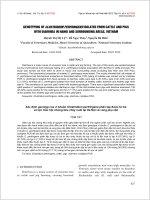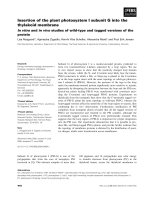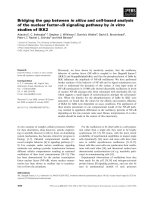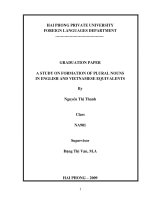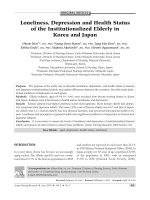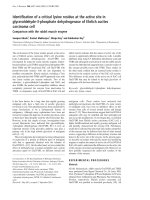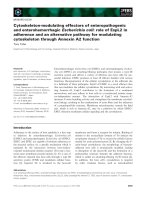status of postnatal care among mothers giving birth at the two hospitals in hanoi and an effect evaluation of home-based postnatal care model
Bạn đang xem bản rút gọn của tài liệu. Xem và tải ngay bản đầy đủ của tài liệu tại đây (281.85 KB, 28 trang )
MINISTRY OF MINISTRY OF HEALTH
EDUCATION AND TRAINING
NATIONAL INSTITUTE OF HYGIENE AND EPIDEMIOLOGY
PHAM PHUONG LAN
STATUS OF POSTNATAL CARE AMONG MOTHERS
GIVING BIRTH AT THE TWO HOSPITALS IN HANOI
AND AN EFFECT EVALUATION OF HOME-BASED
POSTNATAL CARE MODEL
Specialization: Public Health
Code: 62.72.76.01
ABSTRACTOFPhDDISERTATION
HANOI
,
2014
This work has been completed at
National Institute of Hygiene and Epidemiology
Supervisors
1. Asso.Prof. Vuong Tien Hoa, MD. PhD.,
2. Nguyen Thi Thuy Duong, MD. PhD.,
Opponent 1: Prof. Dao Van Dung, PhD
The Central Department of Propaganda and training
Opponent 2: Ass. Prof. Luu Thi Hong, PhD
Ministry of Health
Opponent 3: Ass. Prof. Ngo Van Toan, PhD
Hanoi Medical University
The thesis will be public defensed at Institutional committee in National
Institute of Epidemiology and Hygiene at ,
date month year 2014
Full dissertation could be found at
- National Library
- The library of National Institute of Epidemiology and Hygiene
LIST OF PUBLISHED ARTICLES
RELATED TO DISERTATION
1. Pham Phuong Lan, Vuong Tien Hoa, Le Anh Tuan, Nguyen Tuan
Hung (2011); “Knowledge, practice and needs of postnatal care
among mothers giving birth at National Hospital of Obstetrics and
gynecology and Ba Vi District General Hospital”, Preventive
Health Journal, Volume XXI, Number 7 (125), pp.165-174
2. Pham Phuong Lan, Vuong Tien Hoa, Nguyen Thi Thuy Duong, Le
Anh Tuan (2012), “Effect evaluation of home-based postnatal care
at National Hospital of Obstetrics and Gynecology and Ba Vi
District General Hospital”, Preventive Health Journal, Volume
XXII, Number 6 (133), pp.124-132.
3. Pham Phuong Lan, Nguyen Thi Thuy Duong, Vuong Tien Hoa
(2013), “Analyse related factors to mother's postnatal care
knowledge and practice at National Hospital for Obstetrics and
Gynecology and Bavi Hospital 2011”, Preventive Health Journal ,
Volume XXIII, Number 7(143). Pp. 110-116
ABBREVIATIONS
BPTT
Contraceptive methods
Biện pháp tránh thai
CS
Care
Chăm sóc
CSTN
Home-based care
Chăm sóc tại nhà
CSSS
Postnatal Care
Chăm sóc sau sinh
CSHQ
Efficiency index
Chỉ số hiệu quả
HQCT
The efficiency of
Intervention
Hiệu quả can thiệp
Ptct
Propotion before intervention
Tỷ lệ trước can thiệp
Psct
Propoption after intervention
Tỷ lệ sau can thiệp
KHHGĐ
Family Planning
Kế hoạch hoá gia đình
PSTW
National hospital of
Obstetrics and Gynecology
Phụ sản trung ương
SKSS
Reproductive Health
Sức khỏe sinh sản
TCMR
National Immunization
Program
Tiêm chủng mở rộng
TCYTTG
World health organisation
Tổ chức Y tế thế giới
1
INTRODUCTION
1. Rationale
Postnatal period is very important period that denotes the physical,
emotional changes turning "a woman" into "a mother". This is also a
sensitive period for mother's and newborns health. According to World
Health Organisation, there is about 13% & 4% of maternal mortality and
5% & 15% of newborn mortality occur during the first and the second
week after birth. Therefore, mother's knowledge on postnatal care
become vital that will help them to detect early any abnormal signs of
themselves and their babies contributing to a decrease in maternal and
newborn morbidity and mortality. Promoting postnatal care knowledge
among mothers could help them provide good practices of postnatal care.
While the need of postnatal care among mothers increases, many forms
of postnatal care have been presented of which home-based postnatal
care should be a good one to share the burden of care with public health
sectors. It raises many questions for the new model of home-based
postnatal care. How effective would it be? What are advantages and
constrains to conduct this activity? Would it be accepted at different
communities? That are reasons to conduct a research named:
“Status of postnatal care among mothers giving birth at the two
hospitals in Hanoi and an effect evaluation of home-based postnatal
care model"
The research is aiming at the followings:
1. Describing status of knowledge, practice and needs of postnatal care
among mothers giving birth at National Hospital for Obstetrics and
Gynecology and Ba Vi District General Hospital in 2011.
2. Evaluating effects of home-based postnatal care service on mothers
giving birth at the two hospitals
2. Findings of the research
- Scientific contribution: The research has fully described knowledge,
practice and needs of mothers on postnatal care in Hanoi in 2011. The
authors also explain related factors to postnatal care with an emphasis on
traditional belief that may use effectively for development of postnatal
care intervention at community levels.
This will be the first research in Vietnam on postnatal care services
provided by health workers in 10 days after birth, at different community
2
of rural and urban.
- Application of the research: Model of home-based postnatal care
provided by health workers will increase good knowledge and practice on
postnatal care among mothers. This intervention should be conducted in
different communities including rural and urban area. Health facilities
from District level should conduct this kind of service at community.
3. Structure of dissertation:
This paper includes 131 pages, divided in 4 chapters that consist of
Introduction: 2 pages, Chapter 1- Overview: 27 pages, Chapter2-
Subject&Research methods: 19 pages, Chapter 3- Results: 51 pages,
Chapter 4- Discussion: 29 pages, Conclusion: 2 pages and
Recommendations: 1 page. It contains 45 tables, 6 charts, 4 objects and a
map. The paper presents 113 references that include 44 Vietnamese and
67 English and a full questionnaire.
Chapter 1
OVERVIEW
1.1. Overview of postnatal care at community
1.1.1. Basic concepts:
- Postnatal period contains postpartum (in 6 weeks after birth) and
newborn period (in 4 weeks after birth).
- According to WHO, definition of postnatal care included all
monitoring, referral for any maternal complications such as hemorrhage,
pain, infection, and all form of counseling on breastfeeding, nutrition,
newborn care and family planning. Newborn care includes early
breastfeeding, keeping warm, cord care and detecting dangerous signs for
examination and treatment.
1.1.2. Physiology of normal postpartum and newborn
At postpartum period, there are some changes in maternal uterus,
vulva, and breast. Some physiological characters occur such as uterus
discharge, breast feeding …. Among newborns, breathing, jaundice, and
other normal physiological signs should be taken into account.
1.1.3.1. Postnatal risks for mothers and newborns
In postnatal period, mothers are at risks of pain, fatigue, insomnia, breast
problem, and others problems such as exhausted, baby blue, stress or
depression.
3
On nutrition, mothers should attain at least 2750 to 2975 Kcal/day for
recovery and breastfeeding. However, according to National Nutrition
Institute, Vietnamese mothers have attained 76% of this requirement of
nutrition. Additionally, mothers should attain other supplements such as
Iron and Vitamin A.
On hygiene and labor, mothers should avoid hard motions for resistance
of hemorrhage, decreasing in breast milk amount, Mothers also should
sleep for 8 hours/day. Mothers are required to take a rush bathing,
cleaning their breast and vulva everyday with warm water that will help
to avoid infection. Moreover, mothers should practice effectively
contraceptives.
Newborn are able to get more health problems such as vomit, dieherea,
fever, difficult breathing, jaundice or more serious problems such as
pathology jaundice, low temperature, etc,.
1.1.4. Contents of postnatal health care
World Health Organisation has launched a guideline of postnatal care
since 1998 and more updated version in 2008. In Vietnam, National
guidelines on Reproductive Health in 2009 has adopted WHO's
guidelines in 2008 on the contents of postnatal care.
1.2. Knowledge, Practice of mothers on postnatal care
In the world, knowledge and practice of mothers on postnatal care still
limit. In some are, postnatal practice are seriously influenced by
traditional belief. In other areas, mothers may not receive a fully care in
postnatal period. Few mothers are able to be harassed or seriously
affected by domestic violence on their health conditions.
In Vietnam, many researches have shown a low level of knowledge
and practice on postnatal care, especially for those living in remote or
mountainous areas. Many mothers in Vietnam have limit knowledge on
nutrition, hygiene and labor requirements, and dangerous signs after
childbirth, as well as the time for active sexual intercourse.
1.3. Home-based postnatal care service
Home-based care service provided by health care workers has been
conducted in all countries in North and West Europe, in some Asian
countries. Home-based postnatal care service can promote mothers'
knowledge and practice on postnatal care; increase the rate of newborn
having breastfeeding and keeping warm.
In Vietnam recently, there are some health facilities have conducted
home-based postnatal care services in big cities. Price for each postnatal
care visit varies from 150.000 VND to 700.000 VND. There is no
4
research on the effect of those services on mothers' knowledge or/and
practice on postnatal care.
Chapter 2
SUBJECT AND RESEARCH METHODOLOGY
2.1. Research site
- National hospital of Obstetrics and Gynecology (NHOG)
- Ba Vi District General Hospital
- Mothers' home
2.2. Research methodology
There are two research designs that best served for the two research
purposes: a cross-sectional and a quasi-experimental research.
2.2.1. Cross-sectional study:
2.2.1.1. Time for data gathering: From February to April/2011
2.2.1.2. Research subjects:
- Mother after childbirth
- Family Representative(s) who take(s) care mothers
2.2.1.3. Sample size:
- For mother
Use the formula:
In which:
Z
2
1-
α
/2
=
1,96, with accuracy of 95%
, d=0,05 is selected odd.
p: % women having good knowldge on postnatal care according to
previous study of Lê Thị Vân, 2003 is 40%. q =(1-p): % women having
poor knowledge of postnatal care = 60%, The sample size is calculated to
be 368.
Taking sample at different areas of rural and urban, we have each
subject group having 368 women. Sum of total women in two areas, we
have 736 women needed for the study. In fact, we recruited 762
women, of which rural area: 373 women, urban area: 389 women.
- Subject 2: Family representatives (Care taker)
In each area, we chose 10 informants for in-deph interview.
p(1-p)
d
2
n=
5
2.2.1.4. Data gathering methods
There are two methods of data gathering in this paper: quantitative
methods (using checklist and structured questionnaires) and qualitative
methods (using guidelines for in-depth interview).
2.2.2. Quasi-experimental study
2.2.2.1.Time of study: from June to September/ 2011
2.2.2.2. Studying subjects: Mothers after childbirth at the two selected
hospitals
- Sdudy group: Mothers after childbirth at the two selected hospitals in
Hanoi in the time of studying who agree to use home-based postnatal
care service, live in Hanoi and surrounding areas, and sign to consent
form to be subject of study.
- Control study: Mothers after childbirth at the two hospitals in time of
studying, who disagree to use any form of postnatal care service, live in
Hanoi and surrounding areas, and accept to be involved in the study.
- Other subject study: Care takers at family, health care workers who
provide services and Health authority at the two hospitals.
2.2.2.3. Sample size:
- Quantitative study: Subjects are women afterbirth. Use teh formular as
the followings:
2
21
2
22111)2/1(
21
)(
])1()1([)1(2[
pp
ppppZppZ
nn
−
−+−+−
==
−−
βα
In which: n
1
: sample size of study group, n
2
: sample size for control
group, P
1
: % women having good practice on postnatal care (PC)
according to previous study of Lê Thị Vân: 40%, P
2
: estimated
propotion after intervention: 50 %, p: (p
1
+ p
2
)/2, Z
1-
α
/2
: accuracy of
95% ), Z
1-β
: sample power (= 80%). Sample size is calculated to be n
1
=
n
2
= 468. Taking 10% more, we have n
1
= n
2
= 519, Total sample size
is: 1038.
-Qualitatite study: including 10 mothers, 10 Care takers, 06 health care
workers.
2.2.2.4. Intervention overview
- Profile: This intervention is a home-based postnatal care service
provided by health care workers for mothers and newborn during 10 days
after hospital discharge, including clinical examination, treatment (if any)
and health counselling.
6
- Aim of the intervention: Improving good knowldge and practice on
postnatal care among mothers and early detecting any dangerous signs of
maternal and child healthh in this period.
- Time of intervention: 10 days after hospital discharge
- Place of intervention: at mother's house
- Contents of intervention: according to the contents of National
Guidelines on RH 2009
- Price of service : in urban area: from 250.000- 430.000 VND/visit, in
rural area: from 125.000 -215.000 VND/visit.
2.3.5. Assessment
An assessment score on mothers' knoewledge and practice on postnatal
care has been used in the study. Total score of knowledge is 42, of which
13 for detecting dangerous signs, 10 for hygiene -labour, 10 for nutrition
and 9 for family planning methods. Total score of practice is 15. If
mother attains ≥50%, she will pass the assessment.
2.4. Data processing and analysing
- EPIDATA 3.1 was used for data entry. SPSS soft ware was used for
data analysis. Descriptive and frequency analysis, T test, Chi square test,
OR and 95% confidence interval were used. The statistical significant
level of p ≤ 0.05 was used.
- Intervention assessment is used through effeciency index and teh
efficiency of intervention.
- Qualitative data is attained by using in-depth interview, tape recoding,
full text of transcription.
Chapter 3
RESULTS
3.1. 1.Descibing status of knowledge, practice and needs of postnatal
care among mothers giving birth at National Hospital for Obstetrics
and Gynecology and Ba Vi District General Hospital in 2011.
3.1.1. Status of postnatal care at community
3.1.1.1. Mothers' profile
In a total of 762 mothers participated in the study, 49% come from
rural area, 51% come from urban area. Most of them are at the age of
under 30 (57,5%), having at least professional high school (71,5% in
urban group, 53,5% in rural group). There is a difference between two
groups on level of education and carrier. More 1/2 of mothers who have
total income per month during 1-3 millions VND. Average number of
7
children is 1.5.
There is 60,9% of mothers experienced Cesarean section. Normal
pregnancy ocupied 90,8%. Th proportion of preterm or/and birth deffect
is low (8,2%). Number of newborn excessed 2500 gram and above is
dominant.
3.1.1.2.Accomodation and postnatal care for mother and newborn
There is a difference of accomodation between the two groups
regarding types of housing and source of wate (only 4,6% mothers at
urban area using drilling water while 26,2% mother at rural used drilling
water, p<0,001). Main care takers for postnatal care at home are mother -
in-law (55,2%), biological mothers (52%), husbands (44,3%), home
servant (12,3%), and sisters (9,8%). Number of mother who has no
support from others is very low 0,5%. Source of information of postnatal
care that mother attainned are different between two areas. Mother from
urban area receive information mainly from health care workers (46,5%),
and Internet (46,2%) while mothers in rural area receive from their
mothers (43,3%) and mother-in-law (42,5%).
3.1.1.3. Health status of mothers and newborns
- Mothers' health:
Only 10-20% mothers are coping with health problems afterbirth.
Common health problems are bleeding, infection, and breast problems
respectively. Morbidity rate of mothers in rural area is higher than this of
mothers living in urban area. More mothers in rural group have emotional
problems such as assominia (17,3% among rural group compared with
5,4% among urban area), feeling exhausted (7,7% in rural group
compared with 2,2% in urban group) and blame themselves (2,85% in
rural group compared with 0% in urban group).
- Newborns' health: Common health problems among newborn are
juandice 3,5% and orher 6%. Newborns in rural group have more health
problems than those in urban group.
3.1.2. Mothers' knowledge on postnatal care
3.1.2.1. Postnatal care knowledge in 4 main categories
8
38%
62%
21,70%
78,30%
13%
87%
33,80%
66,20%
0%
10%
20%
30%
40%
50%
60%
70%
80%
90%
100%
Detecting
dangerous
signs
Labour-
Hygiene
Nutrition Family
Planing
Pass False
Figure 3.1. Mothers' knowledge of postnatal care in 4 main categories
According to 4 categories of knowledge that have been used in this
study, detecting dangerous sign is highest rate of 38%, then family
planning: 33,8%, hygiene -labor: 21,7% and nutrition 13%. Most of
mothers thought that there is no eligible problem for them and their
babies in postnatal period. Mothers showed their passive thinking on
postnatal health care for themselves and their babies as many other care
takers get involved.
“…I only wish that "mother circle, baby square" (at good health). I
don't care about postnatal care as I receive fully support from my mother
and mother-in-law. I feel confident …” (BM03PSTƯ).
Passive thinking on postnatal period as a safe one is also common
among other family members
“ Oh, we only care about labor time There is a proverb “Being
pregnant as at gate of cemetory”…I don’t have any to think of instead of
taking rest for my self and taking care of my baby …” (GD07BV)
3.1.2.2. General knowledge of postnatal care
9
63,8%
36,2%
Pass False
Figure 3.2. General knowledge of postnatal care
Mothers' general knowledge of postnatal care is still limit. There are
only 36,2% of mother has passed the assessment score in this study.
3.1.3. Mother's practice of postnatal care
3.1.3.1. PC practice in the 4 categories
Table 3.21. Postnatal care practices on labor and hygiene
by living area
Assessment contents Urban
n=389
Rural
n=373
Total
n=762
Labor
N % N % n %
As usual 32 8,2 40 10,7 72 9,4
Taking rest 357 91.8 333 89,3 690 90,6
Sleep
< 8hours/day 59 15,2 34 9,1 93 12,2
≥8 hours/day
330 84,8
339
90,9 669 87,8
Postpartum hygiene
Taking bath with warm water 281 72,2 279 74,8 560 73,5
Taking bath as usual 13 3,3 3 0,8 16 2,1
Avoid bathing 95 24,4 91 24,4 186 24,4
Vulva and breast cleaning
Yes 262 67,4 238 63,8 500 65,6
No 127 32,6 135 36,2 262 34,4
Most of mothers have good knowledge on labor and hygiene.
However, few mothers still have bathing resistance. There is 1/3 of
mothers does not clean vulva and breast everyday (34,4%).
10
Table 3.22. Nutrition practice in postnatal period by living area
Contents Urban
N=389
Rural
n=373
Total
n=762
n % n % N %
Meal amount
As usual 24 6,2 26 7,0 50 6,6
Bigger than usual 319 82,0 294 78,8 613 80,4
Meal restriction 46 11,8 53 14,2 99 13,0
Vitamin A taking
Yes 3 0,8 0 0 3 0,4
No 381 97,9 369 100 750 99,6
Iron table taking
Full dose 96 27,4 130 35,1 226 31,4
Less dose 35 10,0 79 21,4 114 15,8
No taking 219 62,6 161 43,5 380 52,8
Intensive breast feeding
Yes 377 96,9 362 97,1 739 97,0
No 12 3,1 11 2,9 23 3,0
The rate of mothers reported taking Vitamin A and Iron tablets in
postnatal care period is low. There is only 0,4% of mothers use Vitamin
A and 15,8% of mothers taking full dose of Iron tablet. The rate of
mothers taking supplements afterbirth in rural group is more than this in
rural group (21,4% compared with 10% respectively). The rate of
intensive breastfeeding is high: 97%.
Qualitative study found that there is few mothers looked for traditional
medicine for their babies’ treatment. However, some of them used
traditional herds for curing themselves. For example, mothers used opium
for pain relief at uterus or use hot rice bracket massage on breasts for
more milk.
3.1.3.2. Mothers' general practice on postnatal care
11
64,7%
35,3%
Pass False
Figure 3.4 Mothers' general practice on postnatal care
The rate of mothers having good practice on PC in this study is 34.6%
that very close with this of 35.4% in Le Thi Van's study in 2003.
3.1.4. Related factors to mothers' knowledge and practice on
postnatal care
Study results showed age group of mother, number of living
children may influence to their knowledge and practice of PC. In
particularly, mothers at 30 years old and above; have from 2 children are
eligible to have good knowledge and practice of PC from 2.8 to 3.3 times
higher than those are at under 30 years old and having only one child.
Table 3.26. Association between knowledge and practice of PC
Knowledge of
mothers on
Postnatal
care
Practice of PC
Passed False Total
Passed 391(79,5) 95 (34,9) 486(63,7)
False 101(20,5) 175(65,1) 276(36,3)
Total 492 (100) 270 (100) 762(100)
OR, CI
95%
, p OR=7,2; CI: 4,9- 10,4, p<0,0001
Knowledge of PC is a dominant to practice of PC. Mothers, whose
knowledge of PC is false will have more 7 times higher possibility to get
false practice of PC. There is significant difference with OR=7,2, CI: 4,9-
10,4, p<0,0001 (table 3.26). Other factors such as level of education of
mother, living areas, mothers' carriers, or/and monthly income do not
have any influence on knowledge and practice of mothers on PC.
3.1.5. Mothers' need of postnatal care services
12
Table 3.29. Mothers' need of postnatal care services
Needs Urban Rural Total
N % % n %
Physical conditions
Received assistance to do house
work
267 68,3 187 50,1 454 59.6
Received longer maternal leave 178 45,5 144 38,6 322 42.3
Taking long rest 174 44,5 140 37,5 314 41.2
Taking examination, health
check up
274 70,1 232 62,2 506 66.4
Baby care 225 57,5 198 53,1 423 55.5
Spirit conditions
Received information of PC
301 77,0 277 74,3 578 75.9
Received supported feelings/
sharing from others
237 60,6 189 50,7 426 55.9
Have no burden of financial aid
for living
193 49,4 164 44,0 357 46.9
Others
2 0,5 11 3,0 13 1.7
Needs for receiving information of PC become the first need with
75,9%. Need of health check up goes the second range with 66,4%.
Needs for house work assistance and emotional assistance are the next
(table 3.29).
3.1.6. Needs of home-based postnatal care service
After receiving a counseling on home-based postnatal care service, the
rate of urban women accept to participate in the service is high of 96%,
while this rate among rural women is only 50%. The difference is
statistical significant (p <0,001).
Reasons for not using the service are having other paid service
(43,2%); expensive cost of service (32,4%), far from home (29,7%). Only
5,1% of mother reported that this service is not necessary.
3.2. Evaluate effectiveness of home-based postnatal care service on
mothers giving birth at the two hospitals
3.2.1. Subject profile
3.2.1.1. Socio-economical characteristics
Studying subjects are mostly at the age of under 40, of which 56,9%
are the age of 20-29. Fewer women are at the age of under 20 or/and
above 40 (<3,5%). There is more 1/2 women having monthly income
from 3 to 10 millions VND/person/month. The rate of women having
more 10 million VND/person/month is under 10%. Average number of
13
living children is 1.55. Number of women in two groups: having the first
child and having two and more children is equally that respectively are
53,4% and 46,6%. Level of education and carrier in study group and
control group are similar.
3.2.1.2. Characteristics of current birth
Because of the selection criteria, 3/4 women participating in the study
experienced CSs. Normal pregnancy accounts for 92%, birth defect is at
low percentage of 8%. Therefore, the proportion of preterm birth or birth
defect is also low (9,6%). Most of newborn are at 2500 gram or more
(64,5%). About 1/3 newborn excess more than 3.500 g (30%). Average
duration of hospitalization is 2.6 days. There is no difference found
between two groups.
3.2.1.3. Accommodation of mothers and newborn
Generally, mothers and newborns have a good accommodation in
postpartum period. Rate of women having private room, clean water
source, standard toilets is high. No difference was found between the
two groups.
3.2.2. Effectiveness of intervention towards mothers' knowledge of
postnatal care
Intervention has been seen having positive effect towards women's
knowledge of PC.
37,20%
54,10%
37,80%
40,90%
0%
10%
20%
30%
40%
50%
60%
Intervention group Control group
Before intervention After intervention
Figure 3.5. Change before and after using home-based PC service
General knowledge of PC has been much improved after intervention
among women in study group. The change is statistical significant with
p<0,001, efficiency index: 45,4%. Change in control group is not
statistically significant with p>0,05, efficiency index: 8,2%. After
intervention, the rate of postnatal care knowledge of mothers in study
14
group has been improved much more than this in control group (p<0,001,
efficiency of the intervention: 37,2%).
Table 3.37. Changing in mothers' PC knowledge
on detecting dangerous signs
Assessment Study group Control group
before
intervention
After
intervention
CSHQnct, p
before
intervention
After
intervention
CSHQnc
P
n
%
n
%
n
%
n
%
Passed
19
3
37,2
271
52,2 40,3%
p<0,001
195
37,6
212
40,9 8,8%
p>0,05
False
32
6
62,8 248 47,8 324 62,4 307 59,1
Index
Efficiency of intervention (HQCT) = 31,5%; p<0,001
After intervention, knowledge of detecting dangerous sign among
mothers in study group increases sharply with p<0,001, efficiency index:
40,3%. Changing in knowledge of detecting dangerous signs among
women in studying group is statistically significant compare with this
among women in control group with efficiency of the intervention:
31,5% (p<0,001).
Table 3.38. Changing in women’s' knowledge of labor and hygiene
Assessment Study group
Control group
before
intervention
After
intervention
CSHQ
nct, p
before
intervention
After
intervention
CSHQnc
P
n % n % n % n %
Pass
137
26,4
260
50,1 89,8%
p<0,001
115
22,2
149
28,7 29,3%
p<0,05
False
382 73,6 259 49,9 404 77,8 370 71,3
Index
HQCT = 60,5%, p<0,001
After intervention, knowledge of labor-hygiene among mothers in
study group increases sharply with p<0,001, efficiency index: 89.8%.
Changing in knowledge of detecting dangerous signs among women in
studying group is statistically significant compare with this among
15
women in control group with efficiency of the intervention: 60.5%
(p<0,001).
Table 3.39. Changing in women's knowledge of nutrition
Assessme
nt
Study group Control group
before
intervention
After
intervention
CSHQnct
, p
before
intervention
After
intervention
CSHQnc
P
n % n % n % n %
Pass
104
20,0
187
36,0 80,0%
p<0,001
101
19,5
140
26,9 37,9%
p<0,05
False
415 80,0 332 64,0 418 80,5 379 73,1
Index
HQCT = 42,1%; p<0,01
After intervention, knowledge of labor-hygiene among mothers in
study group increases sharply with p<0,001, efficiency index: 80%.
Changing in knowledge of detecting dangerous signs among women in
studying group is statistically significant compare with this among
women in control group with efficiency of the intervention: 42.1%
(p<0,001).
Table 3.40. Changing in mothers' knowledge of family planning
Assessment Study group Control group
before
intervention
After
intervention
CSHQnct,
p
before
intervention
After
intervention
CSHQnc
P
n % n % n % n %
Pass
175
33,7
260
50,1
48,7%
p<0,001
175
33,7
208
40,1
19,0%
p<0,05
False
344 66,3 259 49,9 344 66,3 311 59,9
Index
HQCT = 29,7%; p<0,01
After intervention, knowledge of labor-hygiene among mothers in
study group increases sharply with p<0,001, efficiency index: 48.7%.
Changing in knowledge of detecting dangerous signs among women in
studying group is statistically significant compare with this among
women in control group with efficiency of the intervention: 19%
(p<0,001).
16
3.2.3. Effect of home-based postnatal care service on PC practice
36,40%
54,90%
34,10%
37,80%
0%
10%
20%
30%
40%
50%
60%
Intervention group Control group
Before intervention After intervention
Figure 3.6. Changing in mothers' PC practice
The intervention of home-based PC service has significantly made a
change in mother's PC practice. After intervention, PC practice among
mothers in studying group has been improved much compared with this
among women in control group with p<0,001, efficiency index (CSHQ):
50,8%. While, change in PC practice among women in control group is
not statistically significant with p>0,05, efficiency index:10,9%. After
intervention, PC practice among women in studying group has much
improved compared with that among women in control group with
p<0.001; efficiency of the intervention: 39.9%.
3.2.4. Mothers' assessment on service quality
100% of mothers in study group presented their good feedback on the
intervention. They said service providers were caring and enthusiasm
with their clients.
Quality data showed most of mothers and fathers feel safely when
health workers provide the service:
“This model should be applied widely due to the limit number of
children in a family. Therefore, people are willing to pay for postnatal
care check-up by health care workers" (BM16PSTW)
Most of mothers reported that the cost of services is fair enough for
paying. Some mothers said time for visit is not appropriate as they have
been taken turn for service. This will effect to accessibility of the service.
3.2.5. Service providers' assessment
Health care workers, who involved in the service said the model plays
a very important role in reproductive health care that contributes to
overloaded situation commonly seen in public health settings currently.
17
This model could be applied successfully at community level. Training
for service provider is easily conducted as basic care in a short time.
Service received supports from hospital leaders.
“If the intervention is successful, we will extent clients not only mothers
after childbirth but also patients after any kinds of surgery" (LD01BV)
Some constrains occur during service implementation such as
counseling skills of service providers, weather conditions, client's
cooperation. Mothers in rural area are reported to be more conservative
for asking questions regarding postnatal care.
Chapter 4
DISCUSSION
4.1. Describing status of knowledge, practice and needs of postnatal
care among mothers giving birth at National Hospital for Obstetrics
and Gynecology and Ba Vi District General Hospital in 2011.
4.1.1.Status of postnatal care at community
4.1.1.1.Women profile
Number of women recruited for the study reaches to 100% as designed,
in which the percentages of urban and rural are equal that ensures
representatives of different living areas
4.1.1.2. Mothers' accommodation afterbirth
Women at urban area have a better accommodation afterbirth
compared with those live in rural area. There are 18,3% women in urban
area and 39,2% women in rural area live in 1- floor house. The rates of
using drilling weal water respectively are 8,3% and 26,2%. The
difference is statistically significant with p<0,001.
4.1.1.3. Main care takers afterbirth
Many family members such as mother, mother in-law, sister(s),
relatives, house servant involved in caring for mother and newborn. The
rate of mother who receives no assistance from other is quite low: 0,5%,
The role of husband in postnatal care is not strong. Only 44,3% husbands
take care of their wives and babies afterbirth.
4.1.1.4. Source of Postnatal care information
Women at both urban and rural areas can access easily with many
sources of PC information. There is difference found in main sources of
information in the two areas. Urban mothers seek information through
health care worker (46,5%), and Internet (46,2%) while rural mothers
seek information from their mothers (43,3%) and mothers-in law.
18
Theoretically, home-based postnatal care services could be implemented
in different living areas: rural and urban.
4.1.1.5. Health status of mothers and newborn babies
There is about 10%-20% mothers have health problems after
childbirth. Common health problems are having pains, bleeding,
infections, and breast problems. Mothers in rural area seem to have more
health problems compared with those in urban area. Reasons are mothers
in rural areas have limit access to sources of scientific postnatal care
information or/and services.
4.1.2. Mothers' postnatal care knowledge
4.1.2.1. Mothers' postnatal care knowledge in 4 main categories
Urban mothers seem to have more knowledge on detecting dangerous
signs such as fever, vaginal discharge or abdominal pain than rural
mothers. This would be explained as mother in urban area have more
opportunities to access PC information from health care workers.
Traditional beliefs play very important role that can influence nutrition
course after childbirth. Knowledge of Vitamin A and breastfeeding
are fairly good among mothers. This is a result of good national
propaganda on nutrition currently. On labor and hygiene: there is about
12,1% of urban mothers and 31% of rural mothers believe in water
resistance after childbirth. Poor hygiene could lead to some
gynecological or breast infection. Results showed mothers having limit
knowledge on family planning contraceptives. Only 16% of urban
mothers and 18% of rural mothers know exact time of sexual active after
childbirth. This would be a suggestion for health policy makers to
emphasis on FP counseling for mother after childbirth.
4.1.2.2. General knowledge of PC among mothers
According to results of this study, 36,2% of mothers have good
knowledge of PC. This is similar to a result of Lê Thị Vân's study in Ha
Duong in 2003 as 35,4% but higher than results of Reza Sharaji (Iran) in
2013 (among 316 mothers only 13,3% of mothers having good
knowledge on PC). In general, postnatal care knowledge of urban
mothers is better than that of rural mothers. This is due to many
influencing factors such as accessibility of information sources, main
care takers, economical condition
4.1.3. Mothers' practice on postnatal care
4.1.3.1. Postnatal care in 4 main categories
Most of mothers take maternal leaves that they may have opportunities
to take intensive rest (90,6%), and sleep more than 8hour per day
19
(87,8%). Mothers still have some postnatal care practices based on their
traditional believe. There are 34,4% of mothers do not clean their breasts
and vulvas everyday. This is dangerous practice that could lead to health
problem such as reproductive tract's infection.
Rates of mothers who take supplements such as Vitamin A and Iron
tablets after childbirth are very low. Only 0.4% of mothers use Vitamin A
and 15.8% of mothers take full dose of Iron tablets after childbirth. This
could be assumed that there is a limit of nutrition in contents of postnatal
care counseling. Breastfeeding has become one of the most target of
national nutrition program. At the first two weeks after childbirth, the rate
of breastfeeding is high. However, the rate of mothers using FP
contraceptives is low. This can be explained the time of study is not the
time mothers recommended to have sexual actives. There is no difference
found in using FP contraceptives in two groups.
Results showed rural mothers seem to have more health problems than
those in urban area. The difference is statistically significant with p<0,05.
4.1.3.2. Mothers' general practice on PC
According to the score using in this study, there is 34.6% of mothers
have good general practice on postnatal care. This results is similar to
those of Lê Thị Vân' study in Chi Linh, hai Duong in 2003 (35,4% ) and
Đàm Khải Hoàn's study on 139 Mong ethnic group in Thai Nguyen in
2003 (31.94%).
4.1.4. Related factors of mother's postnatal care knowledge and
practice
Results show age groups of mothers, number of living children and
monthly income are related factor to mothers' postnatal care knowledge
and practices. In particularly, mothers who are at 30 and above, having
from 2 children, having more than 3 millions VND/month are likely
getting pass in postnatal care knowledge and practice. These results are a
little bit different with those in Reza Sharafi's study in Iran of which
related factors are living in urban area, and at the age of under 24. Study
of Le Thi Van also showed level of education of mother would be
another related factor.
Results also shows that mothers whose knowledge of postnatal care
get false will have more 7 times of risk to have false at practice. The
difference is statistical significant with p<0,0001.
This study does not find out relation between mothers' carriers, level of
education towards mothers' knowledge and practice of postnatal care.
This could be explained as mothers' knowledge and practice of postnatal
20
care mainly based on "getting- experiencing-changing". Mothers always
reported by using the words: "previous time" , "I remember in my
previous pregnancy ". She always remembers what she has experienced
in pregnancy and childbirth. This study does not find any related factors
such as accommodation, water source, information source, form of house
towards mothers' knowledge and practice of postnatal care.
4.1.5. Needs of mothers on postnatal care services
There is a strange occurred when assessing needs of mothers on
postnatal care. Basic needs such as accommodation, meals, place for rest
are not at the top of mothers' needs. Instead, there are 75.9% mothers
would like to be provided information of postnatal care. It seems that lack
of scientific information will be the first need of mothers.
Unmet needs of postnatal care currently will lead to imbalance between
quality and quantity of postnatal care contents. Therefore, mothers' needs
of postnatal care should be taken into accounts
Need of a postnatal care service is real. Results showed 100% urban
mothers and 78% rural mothers reporting they need postnatal care visits
by health care workers. This need is higher in urban area as mothers
accessed information easier than those in rural area. Mothers in rural area
seem to hesitate to receive this kind of service. This result is similar to
another study in Mali, where there is 24.2% women said that they do not
need any kind of postnatal care services. Reasons of refusing postnatal
care services are: costly (32.4%), far from home (29.7%). There is 43.2%
mothers among those refused postnatal care services have invited health
care workers personally for postnatal care visits.
4.2. Evaluating effect of home-based postnatal care service at the
two studied hospitals.
4.2.1. Studying subject profile
Studying subjects are matched by mothers' age group, number of living
children and monthly income. Mothers in the two groups (intervention
and control) are similar to each other regarding to characteristics as being
at 20-29, having monthly income from 3 to 10 millions, having average
number of children at 1.5. Number of mother who have the first child and
those have from two children is equal. Matching will destroy selection
bias that could appear in such a quasi-experimental study.
4.2.2. Characteristics of current pregnancy
As discussed on the recruitment criteria, only mothers having time of
hospital discharge >24 hours are able to participate in study. Therefore,
21
the rate of mothers having CSs is dominant at 77.4%. However, this
results will not influence on mothers' knowledge and practice on
postnatal care. Time for hospital discharge is about 2.6 days that is longer
than that in cross-sectional study.
4.2.3.Accomodation afterbirth for mothers and newborns
Mothers and newborns are at good accommodation afterbirth. The rate
of mother having private room, using clean water source, and hygiene
toilet are at more than 90%.
There are about 98.7% mothers receiving assistance afterbirth. This
would be both advantage or constrains for knowledge, practice of
mothers on postnatal care in the context that those are influenced much
by traditional believes. Mothers' knowledge and practice on postnatal
care may influence by behaviors of main care takers.
4.2.4.Effect of home-based postnatal care service on mothers'
knowledge
Home-based postnatal care service generally meets the needs of
mothers on caring afterbirth that may timely assist the limit of routine
program. The model has positive effect to mothers' knowledge and
practice of postnatal care. After intervention, knowledge of postnatal care
among mothers in study group has been improved with effect index of
45.4%. Additionally, knowledge of mother according to 4 categories
(including detecting dangerous sign, labor-hygiene, nutrition, and family
planning) is also improved compared with these before intervention with
the effect index 40.3% - 89.8%.
4.2.5. Effect of home-based postnatal care service on mothers'
practice
Home-based postnatal care model also strengthens mothers' general
practice on postnatal care. After intervention, mothers in study group
have improved their practices on postnatal care with effect of
intervention of 50.8%. Mothers in study group change their practice level
better than those in control group after intervention with effect index as
39.9%.
Mothers can attain good practice on postnatal care after using the
service.
4.2.6. Assessing average mark difference on mothers' knowledge and
practice of postnatal care
Authors would like to examine average mark of postnatal care
knowledge and practice among mothers in the two groups after
intervention. In which, mean (diff)=mean (total mark of PC
